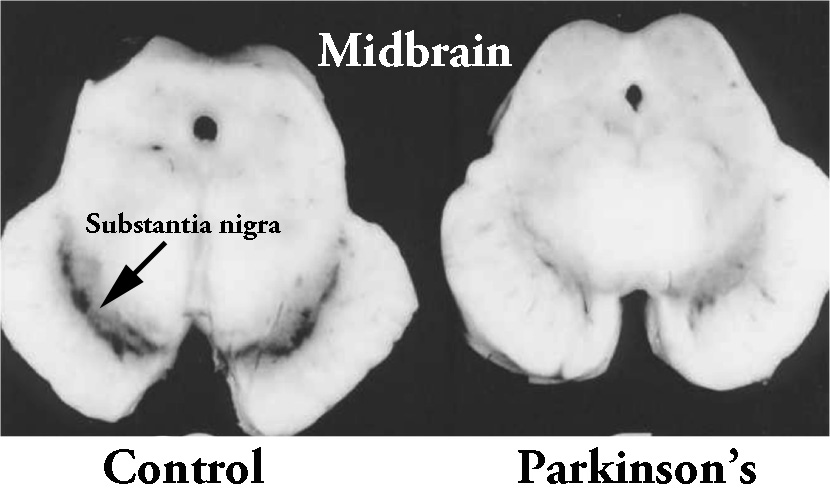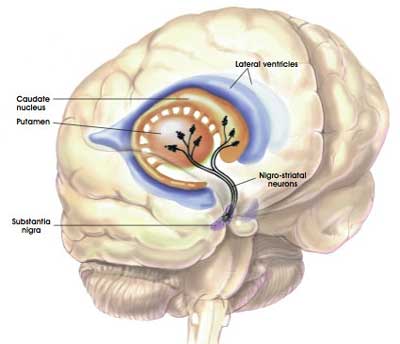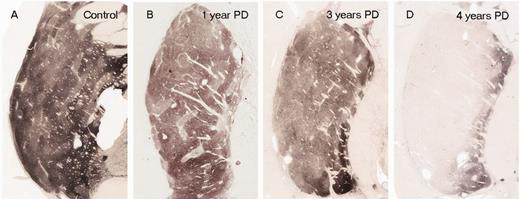|
Cell replacement therapy is a key component of any “cure” for Parkinson’s – replacing the cells that have been lost over the course of the condition. Cell transplantation of dopamine neurons has a long track record of both preclinical and clinical development and represents the most developed of the cell replacement approaches. Two weeks ago, the biotech firm BlueRock Therapeutics announced an agreement under which the pharmaceutical company Bayer AG would fully acquire the company. In today’s post we will discuss why this is major news for the Parkinson’s community and an important development for the field of cell replacement therapy.
|
Source: Wikipedia
On the 8th August, Bayer AG and BlueRock Therapeutics announced an agreement under which Bayer will “fully acquire BlueRock Therapeutics, a privately held US-headquartered biotechnology company focused on developing engineered cell therapies in the fields of neurology, cardiology and immunology, using a proprietary induced pluripotent stem cell (iPSC) platform” (Source).
What is BlueRock Therapeutics?
BlueRock is a biotech firm that was foundered in 2016 as a joint venture between the investment firm Versant Ventures and Leaps by Bayer (with US$225 Million in Series A Financing).
 Versant Ventures is a leading venture capital firm that specializes in investing “in game changing biopharmaceuticals, medical devices, and other life science opportunities”. Leaps by Bayer is an effort by the Pharmaceutical company Bayer at “spearheading a movement to make paradigm-shifting advances in the life sciences – targeting the breakthroughs that could fundamentally change the world for the better”.
Versant Ventures is a leading venture capital firm that specializes in investing “in game changing biopharmaceuticals, medical devices, and other life science opportunities”. Leaps by Bayer is an effort by the Pharmaceutical company Bayer at “spearheading a movement to make paradigm-shifting advances in the life sciences – targeting the breakthroughs that could fundamentally change the world for the better”.
The news on the 8th August means Bayer will acquire the remaining stake for approximately US$240 million in cash (to be paid upfront) and an additional US$360 million which will be payable upon the achievement of certain pre-defined development milestones.
Given that Bayer currently holds 40.8% stake in BlueRock Therapeutics, this announcement values the company at approximately US$1 billion.
Interesting, but what exactly does BlueRock do?
BlueRock is developing technology focused on cell replacement therapy.
And what does this have to do with Parkinson’s?
By the time a person is presenting the motor features characteristic of Parkinson’s, and being referred to a neurologist for diagnosis, they have already lost approximately 50% of the dopamine producing neurons in an area of the brain called the midbrain.
 The dark pigmented dopamine neurons in the substantia nigra are reduced in the Parkinsonian brain (right). Source:Memorangapp
The dark pigmented dopamine neurons in the substantia nigra are reduced in the Parkinsonian brain (right). Source:Memorangapp
These cells are critical for normal motor function – without them, movement becomes very inhibited.
And until we have developed methods that can identify Parkinson’s long before these cells are lost and the motor features appear, some form of cell replacement therapy is required to introduce new cells to take up the lost function.
Cell transplantation represents the most straight forward (but still experimental) method of cell replacement therapy.
How does cell transplantation work?
This ‘old fashioned’ approach to cell transplantation has involved dissecting out the region of the developing dopamine neurons from a donor embryo, breaking up the tissue into small pieces that could be passed through a tiny syringe, and then injecting those cells into the brain of a person with Parkinson’s.

The old cell transplantation process for Parkinson’s. Source: The Lancet
Critically, the people receiving this sort of transplant have required ‘immunosuppression treatment’ for a long period of time after the surgery. This additional treatment involves taking drugs that suppress the immune system’s ability to defend the body from foreign agents. This step is necessary, however, in order to stop the body’s immune system from attacking the transplanted cells (which would not be considered ‘self’ by the immune system), allowing those cells to have time to mature, integrate into the brain and produce dopamine.
The transplanted cells are injected into an area of the brain called the putamen.
What is the putamen?
The bulk of the dopamine neurons in the brain reside in an area called the substantia nigra, near the base of the brain, but they project their branches (or axons) to the several other areas, including the putamen, and this is where they release most of their actual dopamine (the chemical which helps us to move properly).
 The projections of the substantia nigra dopamine neurons & location of the putamen. Source: MyBrainNotes
The projections of the substantia nigra dopamine neurons & location of the putamen. Source: MyBrainNotes
In people with Parkinson’s, the amount of dopamine being released in the putamen decreases over time. The image below demonstrates the loss of dopamine (the dark staining) over time as a result of Parkinson’s (PLEASE NOTE that the time scale presented here varies from person to person):

The loss of dopamine in the putamen as Parkinson’s progresses. Source: Brain
In cell transplant procedures for Parkinson’s, multiple injections of cells are usually made in the putamen, allowing for deposits in different areas of the structure. These multiple sites allow for the transplanted cells to produce dopamine across the entire extent of the putamen. And ideally, the cells should remain localised to the putamen, so that they are not producing dopamine in areas of the brain where it is not desired (possibly leading to side effects).

Targeting transplants into the putamen. Source: Intechopen
Postmortem analysis of the brains of individuals who have previously received transplants of dopamine neurons (and then subsequently died from natural causes) has revealed that the transplanted cells can survive the surgical procedure and integrate into the host brain. In the image below, you can see rich brown areas of the putamen in panel A. These brown areas are the dopamine producing cells. A magnified image of individual dopamine producing neurons (their circular bodies and their branches are stained in brown) can be seen in panel B:

Transplanted dopamine neurons. Source: Sciencedirect
The transplanted cells take several years to develop into mature neurons after the transplantation surgery. This means that the actually benefits of the transplantation technique will not be apparent for some time (2-3 years on average). Once mature, however, it has also been demonstrated (using brain imaging techniques) that these transplanted cells can produce dopamine.
As you can see in the images below, there is less dopamine being processed (indicated in red) in the putamen of the Parkinsonian brain on the left than the brain on the right (several years after bilateral – both sides of the brain – transplants):

Brain imaging of dopamine processing before and after a successful transplantation. Source: NIH
In some cases the individual being transplanted has been able to reduce the amount of Levodopa treatment that they take over time. As the transplanted cells start to produce enough dopamine in the right area of the brain, it allows the individual to function better and require less medication.
This sounds great! Like a cure for Parkinson’s?
Yeah, not quite.
The history of cell transplantation has been a bit of a rollercoaster ride. There have been some success stories and there have also been some disasters. The main issue to date has been the tissue being transplanted and the variability in the quality of the tissue between studies.
This situation has changed recently, however, as researchers have shifted away from the ‘old fashioned’ approach to cell transplantation (using dopamine neurons from a donor embryo), and moving towards developing sophisticated recipes for growing dopamine neurons in cell culture.
Researchers can now grow millions of dopamine neurons in petri dishes, which provides more than enough cells for transplanting numerous individuals with Parkinson’s.
And Bayer Pharmaceuticals buying Bluerock Therapeutics is a major nod from industry to the research community that the protocols for growing dopamine neurons in culture has matured to a point where they are prepared to place a big bet on this field.
The acquistion of BlueRock is rather exciting news.
But it is important to understand that cell transplantation is not a cure for Parkinson’s. Cell transplantation will not halt the progression of the condition. It is simply an experimental method of replacing lost cells. It is hoped that this experimental treatment will allow individuals affected by the condition to reduce their dopamine-based treatment over time. But as far as we can tell the procedure does not slow or stop the underlying mechanisms driving the neurodegeneration associated with Parkinson’s. In addition, the procedure is unlikely to affect non-motor aspects of the disease.
This is why cell transplantation has to be viewed as a component of any ‘cure’ for Parkinson’s. See this on video for more on this (and yes, I know this video needs an update):
Interesting. So what happens next?
The whisper in the wind is that a clinical trial in Parkinson’s of BlueRock Therapeutics stem cell based approach will begin before the end of the year. Thus, the next piece of news that we will be looking out for is the initiation of that trial.
The trial will most likely take place in the US/Canada where BlueRock Therapeutics has most of its operations. But we also know that the company has been exploring opportunities in other regions of the world as well.
In addition, BlueRock is not the only company gearing up for clinical trials in cell transplantation for Parkinson’s. There are a number of additional biotech firms seeking to enter this space (for an example: click here). Therefore, given the Bayer move, I am expecting to hear of news of additional entrants in the near future as others race to join the action.
So what does it all mean?
The Bayer purchase of BlueRock is potentially big news for the Parkinson’s community. Bayer does not appear to be buying intellectual property with the goal of supressing it, as they suggest that “To preserve the entrepreneurial culture as an essential pillar for nurturing successful innovation, BlueRock Therapeutics’ will remain an independent company, operating at an arms length basis” (Source).
The move appears to be the first in a series that will see a number of major players moving into the “cell transplantation for Parkinson’s” space. It is a major vote of confidence for the research community and acknowledgement that the field has matured enough (that is, the protocols for making bona fide dopamine neurons in cell culture are good enough) that big pharma is prepared to start placing bets.
With the current clinical trial ongoing in Japan (Click here to read a previous SoPD post about this), China (Click here to read more about this), and Australia (Click here to read more about this), and BlueRock seeking to start clinical trials before the end of the year, we can expect a lot of research news over the next year or so about cell transplantation for Parkinson’s.
FULL DISCLOSURE – The author of this blog is employed by the Cure Parkinson’s Trust which is funding the ongoing Transeuro cell transplantation trial. The Trust and associated parties have not requested that this material be produced. The author is providing it for educational purposes.
In addition, some of the companies mentioned in this post are publicly traded companies. That said, the material presented on this page should under no circumstances be considered financial advice. Any actions taken by the reader based on reading this material is the sole responsibility of the reader. None of the companies mentioned have requested that this material be produced, nor has the author had any contact with the companies.
It is also important for all readers of this post to appreciate that cell transplantation for Parkinson’s disease is still experimental. Anyone declaring otherwise (or trying to sell a procedure based on this approach) should not be trusted. While I appreciate the desperate desire of the Parkinson’s community to treat the disease ‘by any means possible’, bad or poor outcomes at the clinical trial stage for this technology could have serious consequences for the individuals receiving the procedure and negative ramifications for all future research in the stem cell transplantation area.
The banner for today’s post was sourced from


Interesting but I’m not holding my breath expecting it to work. The idea of planting cells into a brain under oxidative stress and chronically inflamed and infused with that pro-oxidant L-DOPA is a recipe for failure.Better to tackle those basic pathogenic pathways first with simple endogenous agents and then try cell therapies. The more I read here the more I get the impression that the basics are being lost. There are several ‘failed’ trials that embrace that basic pathogenic pathway.. eg antioxidants (vitE, inosine, taurine, Se,), mitochondrial support (eg CoQ), and some scrappy trials with vit D3. But all were tested individually. It makes much more sense to this cell biologist to to apply these physiological agents IN COMBINATION.: the systems biology approach. But there’s no profit to be had in physiological agents. I practise what I preach and am in the third year of refining my combination therapy ,for my drug-naive iPD, and reckon I have a better chance of slowing or stabilising progression than most of what I read on here. That said SoPD is useful as a way of keeping tabs on the latest science, so I do appreciate the work put in !!. But I was a uni researcher for long enough to know that academic science creates its own targets, plaudits and directions that can easly end up following false trails and fail. My suggestion to Blurock and many other ventures is that they need to take a combination approach to quieting brain oxid stress/supporting mitos/suppressing inflammation and then apply their cells. or,growth factors or whatever.
LikeLike
Hi Peter. My name is Holden. I’m interested in hearing a bit more about your combination therapy. I’m relatively recently diagnosed with iPD and have been on a low dosage madopar regime (3 x 60mg per day) for about six months now. However I’m not sure the meds do anything for me, and as you point out, there is the school of thought that Ldopa type meds can in fact create additional oxidative stress on the brain.
Are you able to share a bit more about your “combination therapy”?
Holden Hohaia
LikeLike
Hi Holden,
Briefly: alpha-lipoic acid ( Geronova) acyl carnitine,selenium, coenzyme Q, choline, B-complex, multivit ( no minerals especaily not iron), fish oil for DHA and EPA (also contains tocopherola), vitamin D3 12,000 IUpd., vit K2., melatonin at night.
I get idea of safe doses from webMD.
D3 is a high dose aimed at suppressing auto-inflammation and is contentious, but see:
https://www.sciencedirect.com/science/article/abs/pii/S0960076018306228#bib0410
D3 promotes most of the anti-oxidant defenses, eg review: https://www.ncbi.nlm.nih.gov/pmc/articles/PMC4938033/pdf/rstb20150434.pdf and https://www.researchgate.net/publication/277251978_Vitamin_D_A_custodian_of_cell_signalling_stability_in_health_and_disease/link/556ec1b408aeab777226ad9e/download
Beware: it is my personal experiment. I think I understang what I am doing but like most professors I am not lacking in self-belief. I could be wrong.
Peter
LikeLike
Thanks Peter. I’ll definitely look into the leads you’ve given me. Much appreciated.
Holden
LikeLike
Mr. Cobbold,
In reference to your comment, “It makes much more sense to this cell biologist to apply these physiological elements IN COMBINATION” – I agree completely- it makes much more sense than testing one element at a time. I suggest you look at the website wehaveparkinsons.com if you are interested in combination therapies. I have been taking it for 18 months and seen no progression.
Best regards,
Nadra Holmes
LikeLiked by 1 person
Nadra, At the start of tremor I has bad leg cramps in morning, I took D3, resveratrol and NAC and they cleared in two months. I no longer use resveratrol or NAC in the expectation the D3 covers their major actions, and a nagging concern, possibly unjustified, about side-effects long term. Peter
LikeLike
Hi Simon, Thanks very much for another insightful, constructive, hope-filled post.
Hi Peter / Simon – is there a well moderated forum for sharing / discussing experiences with self-selected health supplements?
Simon – is there a science based method for tapping in to the experiences of what I believe is a significant population of PwP who are self-supplementing? Particularly the wehaveparkinsons.com customers (TUDCA / NAC / EGCG amongst other ingredients)
LikeLike